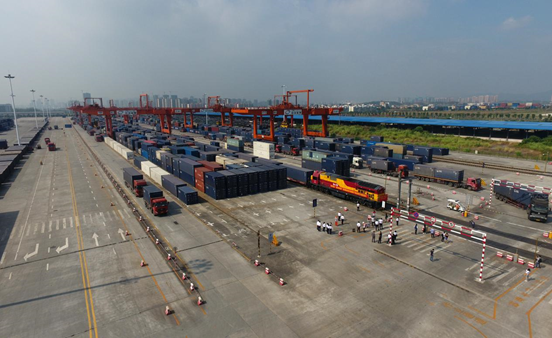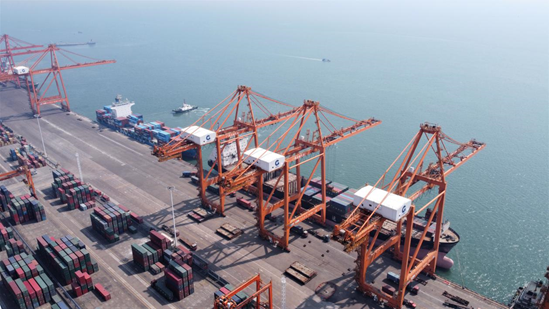

(Written by Chen Libing / Translated by Chen Zhiying)Although the epidemic sweeping the world has forced the logistics corridors in many regions to pause, the New International Land-Sea Trade Corridor under the China-Singapore (Chongqing) Demonstration Initiative on Strategic Connectivity (hereinafter referred to as the China-Singapore Connectivity Initiative) has not stagnated. On the contrary, with the normalization of epidemic prevention and control and the implementation of multiple favorable policies, the freight volume of Chongqing, Guizhou and other western provinces and cities exported to the world via Guangxi Beibu Gulf port has increased rapidly. According to the data, in the first half of 2020, 1,691 trains of sea-rail intermodal transport of the New International Land-Sea Trade Corridor have been put into operation, with a year-on-year increase of 674 trains, an increase of 66.3%, showing great vitality of the corridor.
Behind these achievements, what role did the New International Land-Sea Trade Corridor play in building the Belt and Road? During the epidemic, how did it help China to resume economic and trade exchanges with ASEAN and other places? China-ASEAN Panorama interviewed Han Baochang, Director of China-Singapore (Chongqing) Demonstration Initiative’s Administration Bureau online on the above issues.

An innovative Initiative with high starting point and high level
“The China-Singapore Connectivity Initiative is the third intergovernmental cooperation Initiative between China and Singapore after Suzhou Industrial Park and Tianjin Ecological City. Different from the first two Initiatives, the China-Singapore Connectivity Initiative is no longer limited to physical space, but a leap from physical space to intangible space. It can be said that this is a new mode of cooperation initiated by the leaders of the two countries with great foresight,” said Han Baochang.
Taking Chongqing as an operation center, the China-Singapore Connectivity Initiative will effectively promote Chongqing to become a leading modern connectivity and service economic center in western regions, and by extending the successful experience of Chongqing to other provinces and regions in western China, a new pattern will be formed to drive the opening and development of the whole western region and even a larger region.
“Since the launch of the Initiative in November 2015, we have been adhering to the spirit of “high starting point, high level and innovate in a new way” put forward by President Xi Jinping, putting the Initiative in the overall cooperation of the two countries and striving to promote the development of western regions and even larger regions. China and Singapore have signed 68 cooperation agreements of various platforms and 228 contracted cooperation projects by the end of July 2020, with a total amount about US$ 32 billion and a landing rate of more than 90%. The China-Singapore Connectivity Initiative has gradually become a new name card for the Belt and Road international cooperation,” said Han Baochang.
Relying on the three-level cooperation mechanism of China-Singapore Connectivity Initiative, the New International Land-Sea Trade Corridor jointly built by western China and ASEAN countries such as Singapore has become a landmark Initiative under the China-Singapore Connectivity Initiative, providing a convenient access to seas for the foreign development and opening up of western China, and a significant opportunity for Singapore and other ASEAN countries to cooperate with western China and even with the Belt and Road.
“The development of the New International Land-Sea Trade Corridor will be of great significance to the development of the Silk Road Economic Belt, the 21st Century Maritime Silk Road, the connection of the Belt and Road with the Yangtze River Economic Belt, the opening up and development in western China, and the building of the community with a shared future for China and ASEAN,” said Han Baochang.
From “point-to-point cooperation” to “a comprehensive one”, the new corridor has been accelerating its speed
In July 2020, in Pingxiang, the border between China and Vietnam, a special train from Chongqing to Vietnam carrying electronic products will be allowed to enter Vietnam after the customs declaration in Pingxiang railway port is completed. After obtaining the qualification of designated supervision site for imported fruits in February 2020, Pingxiang railway port has realized “paperless customs clearance”, greatly improving the customs clearance efficiency of cross-border trains such as China-Europe Railway Express.

The positive change of Pingxiang railway port is only a microcosm of the accelerated development of the New International Land-Sea Trade Corridor. Behind it are the joint efforts of the provinces and cities of western China, and the governments and enterprises of ASEAN countries.
“The New International Land-Sea Trade Corridor was first beneficial from Guangxi’s active promotion, and then Guizhou, Gansu, Qinghai and other provinces and cities actively participated in, constantly expanding the friend circles. At the same time, the active exploration of enterprises has also played a good supporting role in promoting the development of the New International Land-Sea Trade Corridor at the government level. For example, enterprises such as Guangxi Beibu Gulf International Port Group Co., Ltd and Chongqing Western Logistics Park Group actively cooperated and established China-Singapore (Chongqing) Southbound Channel Logistics Development Co., Ltd. The trial operation of rail-sea intermodal train was started in April 2017. In terms of highway, buses from Chongqing Highway Transportation ASEAN International Logistics Co., Ltd. drove to Vietnam through Pingxiang, Guangxi. It can be said that the explorations of the enterprises have greatly inspired us and laid a good foundation for the formal operation of the New International Land-Sea Trade Corridor,” said Han Baochang. During the process, China-Singapore (Chongqing) Demonstration Initiative’ Administration Bureau also gave full play to the Chongqing operation center and promoted the expansion of the New International Land-Sea Trade Corridor from point-to-point cooperation between China and Singapore to a comprehensive level between western China and ASEAN.
Promote the New International Land-Sea Trade Corridor in a multi-dimensional and multi-level way. In the past two years, Chongqing has played a leading role in connecting relevant provinces and regions in western China to participate in the Asian Logistics and Shipping Conference in Hong Kong, and jointly held the forums on the New International Land-Sea Trade Corridor in regional international exhibitions such as the Western China International Investment and Trade Fair in Chongqing, the China-ASEAN Business and Investment Summit in Guangxi, and the China (Guizhou) International Liquor Expo in Guizhou, to continuously enhance the popularity and influence of the New International Land-Sea Trade Corridor.
Innovating the organization and the operation of the corridor. In the development of the New International Land-Sea Trade Corridor, a “1 + 3 + 1” cooperation mechanism has been explored and established. “1” represents the inter-provincial joint conference mechanism of western provinces (regions and cities), “3” the guarantee mechanism of Customs, railway and bank supporting the development of the New International Land-Sea Trade Corridor, and “1” the cross-regional public operation platform of the corridor.
Strengthen the docking of strategic planning. We will explore and promote the docking of the New International Land-Sea Trade Corridor with the China-Indochina Peninsula Economic Corridor, the China-Laos Economic Corridor, the China-Myanmar-India Economic Corridor and the new Eurasian Continental Bridge Economic Corridor, and advance the integration of the New International Land-Sea Trade Corridor into the Lancang Mekong Cooperation (LMC) and ASEAN cooperation mechanism in a new way. In 2020, the New International Land-Sea Trade Corridor was successfully incorporated into the third Lancang-Mekong Cooperation Leaders’ Meeting and became an important content of its outcome documents. During the meeting, the Joint Chairman's Statement on the Docking and Cooperation Between the Lancang-Mekong Cooperation and the New International Land-Sea Trade Corridor was issued, proposing that relevant important contents should also be included in the Vientiane Declaration of the Third Lancang-Mekong Cooperation Leaders’ Conference, which marked that the New International Land-Sea Trade Corridor international cooperation has taken a solid step forward.
As for the breakthrough in the incorporation into the LMC, Han Baochang said: “Although Chongqing is not under the framework of the LMC, in fact, Chongqing has always been concerned about the mechanism of the LMC. Now, the New International Land-Sea Trade Corridor connects provinces and cities in Western China with countries along the Lancang-Mekong River, endowing the Lancang-Mekong Cooperation with new connotations. Thus it will become an important part of the cooperation mechanism. Especially after China-Laos Railway are completed, the links between the provinces and cities in western China and ASEAN countries will become closer, not only in logistics, but also in trade and industry cooperation. Therefore, the New International Land-Sea Trade Corridor will be in deep accordance with the development strategies of the LMC and other countries, which is conducive to the economic and social development of all countries.”
Deepen international cooperation and build international logistics corridor system
Compared with traditional routes, the New International Land-Sea Trade Corridor takes advantage of railway, sea transportation, highway and other transportation modes to reach all parts of the world through Guangxi Beibu Gulf, which greatly shortens the time, compared with setting off from eastern regions. During the epidemic, the New International Land-Sea Trade Corridor has become a major corridor for the circulation of food and medical materials in China and Singapore.

According to Han Baochang, during the epidemic, Chongqing exported 60 tons of Chrysanthemum from Yunyang and 25 tons of Citrus from Zhongxian County to Singapore through cold chain logistics of rail-sea intermodal transportation via the New International Land-Sea Trade Corridor, creating a “new demonstration” for exporting agricultural products in western regions, which not only helped Chongqing “stabilize foreign trade” during the epidemic, but also provided support for the material supply of Singapore.
“For western China, agriculture accounts for a large proportion, so we are also exploring the development of agricultural products trade, which can not only enrich the food choices of people in ASEAN countries, but also create a new way for farmers in western China to get rid of poverty and become rich. Therefore, in the past two years, we have cooperated with Chongqing Agricultural Department, Chongqing Customs and other relevant departments to export agricultural products from western China to ASEAN countries through the New International Land-Sea Trade Corridor. Thanks to this, China and ASEAN countries have been able to ensure the product supply during the epidemic, which helps both sides resume economic and trade exchanges,” said Han Baochang. In addition, Chongqing will also work with relevant parties to accelerate the international cooperation of the New International Land-Sea Trade Corridor.
On the one hand, relying on the China-Singapore Connectivity Initiative and adhering to the principle of “openness, inclusiveness, internal and external coordination, joint discussion, mutual benefit and win-win situation”, we will carry out exploration and practices at the level of market entities and local government, and then steadily and orderly promote more countries to participate in the development of the new corridor on the basis of common construction between China and Singapore. Hopefully, a new cross-border and cross-regional cooperation mechanism for the New International Land-Sea Trade Corridor can be formed.
On the other hand, we will give full play to Chongqing and Singapore’s roles as two hub cities, perform well in top-level design, prepare a high-level international cooperation plan for the New International Land-Sea Trade Corridor, actively promote the linkage between the New International Land-Sea Trade Corridor and China-Europe Railway Express, and connect Southeast Asia, central Asia, Europe and other markets, forming an international logistics corridor system with “two hubs” and “multi nodes”.
“We need to connect the central Asian countries to the north in the next step, because the New International Land-Sea Trade Corridor is no longer limited to the cooperation between western China and ASEAN. In fact, it should extend its cooperation to central Asia and even Europe, and connect the China-Europe Railway Express. At present, countries in central Asia and Europe are actively promoting it,” said Han Baochang.
Building the Belt and Road
During the epidemic, the New International Land-Sea Trade Corridor bucked the trend, making people look forward to its future development. Talking about the kernel of the development of the New International Land-Sea Trade Corridor, Han Baochang put forward the following points.
We will rely on the China-Singapore Connectivity Initiative, an important open platform, take the development of Chengdu Chongqing Economic Circle as an opportunity, and build an international cooperation mechanism with western regions, under the theme of the New International Land-Sea Trade Corridor, to promote its cooperation width.
We will work with Singapore to explore and push forward the third-party market cooperation, and jointly perform well in the mode of “corridor leading logistics, logistics leading trade, and trade leading industry”, to expand the “depth” of the New International Land-Sea Trade Corridor.
We will strengthen the support of the four major cooperation areas of China-Singapore Connectivity Initiative to the New International Land-Sea Trade Corridor, namely financial services, aviation industry, transportation logistics and information communication, and carry out cooperation with countries along the New International Land-Sea Trade Corridor in joint law enforcement and other fields.
“The New International Land-Sea Trade Corridor has a bright future and needs the joint efforts of all parties. I believe that under the joint efforts of provinces and cities in western China, and of ASEAN countries, we will surely be able to build this corridor into a booster to promote the Belt and Road from a vague formulation to reality, making it an important platform for solid cooperation,” said Han Baochang.
Source: China-ASEAN Panorama
桂ICP备14000177号 Copyright@2006-2013 Guangxi China-ASEAN Panorama Magazine Agency Co., Ltd. All Rights Reserved